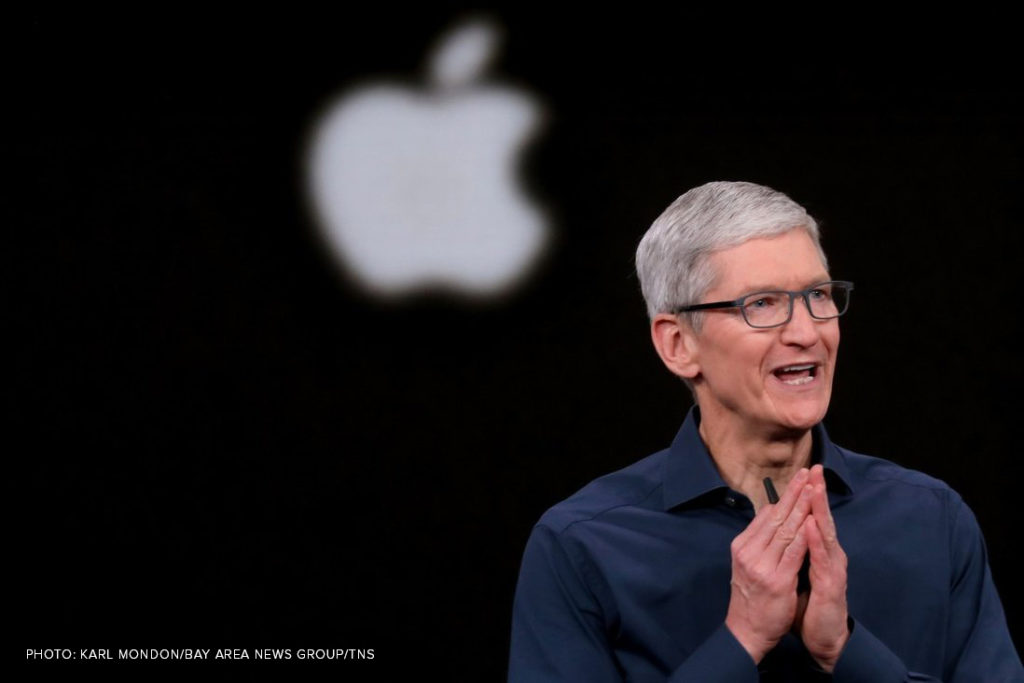
Part 2 : Intuition- Learning How To Unlearn
December 9, 2020

Today, Senior Innovation Strategist Gabriel Ettenson concludes the mind-body journey through our mind with the notion that stress, emotion, and thought should be returned to their original job roles as administrators instead of taking over our daily lives; and by practicing mindfulness and a balanced approach to how we react to the environment, we find ourselves moving through our lives by intuition.
“For the most important decisions in your life, trust your intuition, and then work with everything you have, to prove it right.”
– Tim Cook

We begin part two of our exploration into intuition with a quote from the CEO of Apple Inc who points out the powerful balance between intuition and thought (knowledge); wisdom and experience; gut and mind. Much like Einstein and countless other innovators who’ve ushered disruptive change into the world, Cook alludes to an issue many face in advancing their businesses – trust your intuition. Quiet your mind and listen intently to your gut during this storm of rapid change and evolving environmental conditions.
Part one of this post challenges us to think differently about business in the new normal. It dares us to lean into our intuition and more selectively wield thought like a razor-sharp knife. To do this, we must learn to unlearn. We must unwind the exaggerated credit we give to the mind, thought & knowledge in our past and future success.
By embracing the idea of a new normal, we’re accepting the idea that real, permanent changes are upon us as a result of the pandemic. There’s no denying these circumstances will behave in a way we’ve never experienced before and to an unprecedented degree.
With any change, it’s natural for humans to scavenge the mind for a crystal ball to magically read the fortunes of our future. It’s also natural to grow wildly anxious when slapped with change and the unknown about its potential impact on our lives. It is not until we’re fed advice from someone with a resembling experience, or able to navigate through that change on our own, that we can begin move on. This is because the known allows us to solidify these new concepts in our minds and use them to react to the daily environment with a sense of confidence. But what if we can’t do that?
In the case of COVID, no one person can dig into past experiences to provide turn-by-turn directions to success. There doesn’t exist an off-the-shelf experience that effectively confirms what will be our new normal. We’re in somewhat of a white space – as if we’ve turned the page to a new chapter. There are no words, no margins, no illustrations, and no past experiences from which to draw. And despite historic pandemics and changes they introduced; they are too deep in history to derive any relevant application. Our knowledge is limited, and we need our gut to trail blaze for us.
The voice of the gut can only become louder and clearer when not drowned by the voice of the mind. With the exception of deep sleep, these two voices sing simultaneously like the speakers in a set of ear buds. The mind in one ear, intuition in the other. Mute one side, and the other becomes more amplified. So, how do we develop intuition when the mind’s volume blares at a steady 10? We must practice the art of unplugging thought. A simple way this can be done is through simultaneously practicing mindfulness while gaining a new understanding of why it is that the mind has become so overpowering; thought has become so persistent and knowledge has pushed intuition into the background.

Stress, Emotion and Thought – Simple Administrators Turned Omnipotent Dictators
As we delve into these three components of day-to-day existence, it’s important to understand that they are, by nature, just three links in a chain of events that enable us to process and react to the various occurrences in our daily lives. With each occurrence, we move from the awareness of the event (stress) to a need to anticipate its meaning (primal emotional response), and finally, to determining a correct reaction (thought and physical action). It’s a highly efficient process that serves us well in most circumstances. Where this process fails, is when we are faced with unfamiliar territory.
Despite this seemingly elementary chain of events, in modern day society, our stress levels have become unbearable, our emotions uncontrollable, and our thoughts have carried us away to a fixed position in a scary non-existent future. Existing in that future comes at the cost of being present, which is where we must be to pause, hear our inner guide and create success through creative and correct reactions.
Now, let’s explore these chain links and see them for what they are, rather than what they’ve become.
Stress – A benign, yet purposeful force

When translating the word stress, most default to describing an undesirable state of being (being “stressed out”) which should not exist (being “stress free”). These are all rooted in misunderstandings and why many products are inaccurately sold to eliminate stress or allow one to have less stress. The reality is, we cannot live without stress and we cannot even reduce it in actuality. What we can do is change the way we react to stress, which leads to the desired outcome of preventing a chronic state of worry, fear and concern; a state of feeling anxious.
Stress, by definition, is simply a state of tension in the body caused by a “stressor.” On a deeper level, if we can view our bodies as a giant network of cells, stress is the physical deformation of certain cells in our body as a result of a change in the internal or external environment; one that provides information to the cell and therefore allows the cell to interpret and produce an appropriate response. It is a simple, innate process. Regardless of the circumstances a cell may be dealing with, its only goal is to quickly react with the intention of achieving a swift return to balance, a restful state of homeostasis.
So, whether you’re looking at it from the cellular perspective or as an individual, stress is nothing more than a physical signal from the environment which serves only to allow us to maintain awareness that we are engaged with a transient, dualistic world that requires engagement if we are to “live” within it.
So how do we take that crucial communication about the environment and interpret it? We use that which we have professed to be evidence of our advanced level of existence over all else, our emotional intelligence.
Emotions – Fear, worry, anxiety and their exaggerated state of importance

If we can accept the truly benign role that stress plays in our life and embrace its necessity, then the question now is how do we develop appropriate responses to our daily stressors? The answer is through a unique two-step translation tool, which begins with our emotions. Emotions, despite their universally accepted state of extreme importance, are nothing more that the human bridge by which we “feel” our way between the body (stress and tension) and the mind (thought and reaction). Emotions can be understood physiologically by a medical doctor or spiritually by a Buddhist Monk. An emotion is triggered in response to a stressor, but remains in a primitive, undefined and formless state until it can attach to a point of reference brought about by the mind and thought.
Anyone who’s watched the movie Inside Out can relate to the mature forms of emotions portrayed by the characters Joy, Sadness, Anger, Fear and Disgust. Ironically, much like humans allow negative emotions to star in their own movie called “Life”, the writers of Inside Out chose to cast Sadness, Anger, Fear and Disgust as dominating roles. Curiously, it is Fear or Worry that often takes center stage. They’re like mini transformers who join forces to create the bigger monster called Anxiety – the character who too frequently sweeps the Emotional Grammy Awards.
But what about Joy, Serenity, Gratitude, Elation, Compassion, Hope, and Inspiration? Why don’t we hear about the rising concerns around disorders pertaining to too much positivity? Why, in knowing the benign nature of stress and its purpose of simply triggering one of many emotions, are we biased towards fear, worry and anxiety as its inevitable soulmates? The answer lies in the mind and our false belief in its ability to serve as a thought-driven fortune teller.
Thought – A Mind-Derived Tool to be Used and Put Down

The body-mind connection is not a new concept, but I do believe it has yet to be embraced at the level it deserves. Perhaps due to its scientific complexity, or simply lost in metaphysical concepts too hard to grasp. Regardless, without a mind, there can be no thought or knowledge. And without thought and knowledge, there can be no point of reference by which a given emotion can move from its shapeless, stress-derived form into a clear identity that serves to drive our physical reaction to the world around us.
Similar to how the simplicity of stress and response is understood in the cells of our body, thought too should be effortless for the human to apply. But despite being a tool meant to be picked up, used, and put down, in white space, the mind sometimes becomes dull and misused. Our tendency is to draw fear, brought about by the unknown, compelling us to seek comfort through a mind-driven copy and paste process; a restrictive process preventing the application of new colors and creativity amidst the white space.
The inherent problem with thought is that it’s formed by our conditioning, our past events, and cannot evolve in the absence of unique experiences. We’re destined to replay the same “Mind Movie” on repeat, starring the award-winning actor, fear (and featuring cameos by sadness and worry). This spiraling reflexive documentary lays the groundwork for a highly efficient conversion of emotional stressors.
Like a knife, thought becomes dull when used in the same, repetitive way. It can only be sharpened and more efficiently utilized when properly sharpened; there is no better sharpener than mindfulness.
Mindfulness – Restoring the Yin and Yang of Thought and Intuition

Mindfulness, at its root, means to be “full of mind” and that is all one needs to fundamentally understand. But much like the word “nothing” was intended to translate the idea of not being classified as a thing yet existing (rather than a word to describe a non-existent void), mindfulness describes the state of being aware of the mind and its thoughts.
As one develops mindfulness and the ability to observe thought rather than identify with it, one does not become less attached to its “stickiness”, but more precise in selecting whichever of the many thoughts is sharp enough for a given situation.
Having said that, the true beauty of building mindfulness is not just the improved ability to wield thought more precisely, but to expand the gaps between the thoughts we choose to use. These gaps are the exact location where intuition exists, and its within that gap where we download the creative framework to build something new, meaningful and transformational.
Let it Sink In and “Go with Your Gut” – Nothing else to do
If you’ve made it this far without allowing the stress of this mind-bending blog to trigger boredom or have managed to fight off past experiences suggesting this preview into the gut and mind to be irrelevant to your future, then I thank you. My wish now is for this foundation to simply settle in and allow a new, hopeful perspective to take shape – one cultivating appreciation for the opportunity being offered by this unique world event. It is indeed a beautiful white space to apply your newly honed intuition and sharpened thought as multi-purpose tool for creating and enjoying the world on the other side, just like Tim Cook.
About Zilis’ Scientific Research & Development Department
Our Scientific Research and Development Department is headed up by Dr. Marielle Weintraub, a hemp industry expert. She holds a master’s and a PhD in Behavioral Neuroscience and is very active in many dietary supplement and hemp industry trade associations, including her role as the current President of the U.S. Hemp Authority. Dr. Weintraub is committed to the continued development of hemp-specific information and testing to fulfill the Zilis mission.
Science posts for Discover are co-researched and co-written by Kelly McGill, Senior Scientific Technical Writer at Zilis. Kelly holds a bachelor’s degree in English and a master’s in Linguistics / TESL. She has been writing science-related content for over 20 years and is an expert in making difficult concepts easy to understand.
Zilis is the creator of UltraCell™, a CBD oil product derived from hemp. Based in Argyle, Texas, a suburb of Dallas-Fort Worth, Zilis is privately held. Visit zilis.com for more information.
SHARE THIS POST
ABOUT THIS BLOG
Discover : The blog with the lifestyle, nutrition, science, and history of the hemp industry.
It’s your go-to for the most up-to-date information on hemp, CBD, dietary supplements, and more! Check it out!







